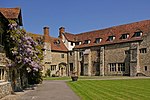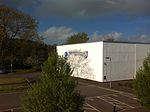Eccles Roman Villa
At Eccles in Kent the remains of a huge Roman Villa with palatial dimensions were excavated between 1962 and 1976. In the second century AD, the villa was almost 112 m long. Over 135 different rooms have been identified throughout the various periods of construction and reconstruction. The villa was abandoned in the Fourth century and much of it was removed in the Thirteenth century for the construction of Aylesford Priory. The villa lies on the east side of the Medway Valley. Roman remains were already known from the Nineteenth century on. During the course of excavation, a number of human burials of Roman date were found deposited beneath the villa floors. Further finds included fragments of Roman pottery and coins. A large post-Roman cemetery was discovered adjacent to the south-east wing of the villa. There were also some remains of a pre-Roman, Iron Age settlement. The earliest Roman villa dates from about 65 A.D. and consisted of a long row of at least 12 rooms, a porticus and probably a second story. Five of these rooms might once have contained floors with mosaics. In front of the house was a long ornamental pool. The building was of high status, as stone buildings were otherwise not so common at this early age in Roman Britain. A huge bath house was built next to it. In several rooms fragments of mosaics were found, most of them in a bad state of preservation. One of them most likely shows two gladiators.The baths were damaged by fire and around A.D. 120 a new bath house and extensions to the dwelling were built, and continued in use until A.D. 180; a third and more extensive bath suite was then erected, and the house once more remodelled by the addition of a rear corridor and new tessellations, as well as a new wing with a channelled hypocaust. A final reconstruction took place after A.D. 290, when the rear corridor was converted into a suite of rooms with hypocaust. Many rooms had tessellated floors, remains of well paintings were found.It has been suggested that the villa was first established by Adminius.The excavation record of the villa reported that much of the building stone was likely robbed in the Medieval period for construction elsewhere, for instance the 12th century St Mary's Church at Burham incorporates Roman tiles into its fabric. The results of the excavations were published in several short reports. A final excavation report is so far not yet published.
Excerpt from the Wikipedia article Eccles Roman Villa (License: CC BY-SA 3.0, Authors).Eccles Roman Villa
Tonbridge and Malling Aylesford
Geographical coordinates (GPS) Address Nearby Places Show on map
Geographical coordinates (GPS)
| Latitude | Longitude |
|---|---|
| N 51.31795 ° | E 0.468948 ° |
Address
Millhall
ME20 7BY Tonbridge and Malling, Aylesford
England, United Kingdom
Open on Google Maps











